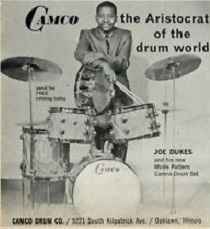LISTEN TO ONE: Blues for Yna Yna
Gildo Mahones had a near-legendary career that took him from Spanish Harlem to 125th Street, where his family moved to an apartment right behind the Apollo Theater and he got his first exposure to music. to Joe Morris's rhythm and blues band, where he played on Morris's big hit, "Any Time, Any Place, Anywhere," Then to the Army, where he became good friends with another young piano player, Berry Gordy, who had this dream of finding a few streetcorner doowop groups, rehearsing them, polishing their act...and then to Minton's Playhouse, where Kenny Clarke asked him to join a trio that would be the house band
at Minton's -- a trio that was soon augmented by Minton's manager Teddy Hill to include Milt Jackson, Sonny Rollins and Percy Heath. Trumpeter Jesse Drakes, who had played with the Minton's group, was joining a new band led by Lester Young, and he brought Gildo along. That gig lasted through most of the 1950s, and then in 1959 he fell in with a newly forming vocal trio, Lambert, Hendricks and Ross, and stayed with them until they broke up in 1964.
Mahones got very little opportunity to record as a leader--two albums for Prestige, then one album in 1990 for a small label, Interplay, which put out some very good jazz records in the 1970s and '80s, but was pretty near the end of its run. Sessions by Mahones and Gil Coggins, another fine and little-remembered pianist, closed the door on Interplay. Of Mahones' two Prestige albums, the first one was intended to be a New Jazz release, but then Bob Weinstock folded New Jazz, and when the album was released on Prestige, it was barely distributed/ So this session, which became a double album, is probably the best-known example of his work.
It's enough to make one wish there were more, and certainly to make one wish that he would have gotten more recognition. This is a piano trio session of the sort that Red Garland was making a few years earlier, not the kind of funk-drenched organ/saxophone sound that was popular in 1964. But Mahones has his own approach to the blues, very individualistic and very much in the tradition,
He's accompanied by George Tucker, very active on Prestige in this era, and no stranger to playing with Mahones, accompanying him on his own first session, and joining him in backing up Jimmy Witherspoon and Ted Curson. Sonny Brown, on drums, is even more obscure than Mahones, but people knew who he was back then, and he worked dates with Ray Bryant and Rahsaan Roland Kirk, among others.
With Ozzie Cadena producing, the trio had a full day of work, recording nearly enough songs for a double alum, and -- with the addition of a few songs from his earlier sessions, a double album it was, entitled The Great Gildo: Gildo Mahones Soulful Piano, the first part being a play on the popular radio comedy of an earlier decade, The Great Gildersleeve. I believe this is the first such packaging in Prestige's catalog. Neither the novelty of the two-disc package not the excellence of the music were enough to make Mahones' name better known, and he is one of the few Prestige artists whose work has never been rereleased on CD by Original Jazz Classics. Nor can it be found on Spotify, although, curiously, a 2018 interview, done shortly before his death, is available on Spotify. So it's up to the classic vinyl hunters, searching through the bins at places like Jim Eigo's Original Vinyl Records in Warwick, NY, to keep him alive. Let's hope that keeps happening.









